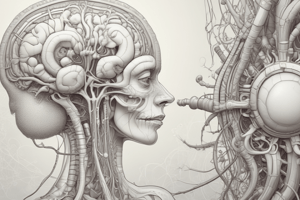Podcast
Questions and Answers
What are the three layers formed from the inner cell mass during early brain development?
What are the three layers formed from the inner cell mass during early brain development?
- Dermatoderm, Neuroderm, Endoderm
- Ectoderm, Dermatoderm, Mesoderm
- Mesoderm, Endoderm, Exoderm
- Ectoderm, Mesoderm, Endoderm (correct)
At what point does the human central nervous system begin to form?
At what point does the human central nervous system begin to form?
- When the embryo is about two weeks old (correct)
- After the blastocyst attaches to the uterine wall
- During the first week
- At conception
Which structure forms after the neural plate folds to create the neural tube?
Which structure forms after the neural plate folds to create the neural tube?
- The embryonic disk
- The central canal and ventricles (correct)
- The blastocyst
- The inner cell mass
What does the ectoderm primarily develop into?
What does the ectoderm primarily develop into?
Which of the following structures does NOT form from the mesoderm layer?
Which of the following structures does NOT form from the mesoderm layer?
What is the main consequence of alcohol consumption during pregnancy on the developing brain?
What is the main consequence of alcohol consumption during pregnancy on the developing brain?
How do rich environments affect brain development?
How do rich environments affect brain development?
What phenomenon do amputees experience due to reorganization of the brain after an amputation?
What phenomenon do amputees experience due to reorganization of the brain after an amputation?
What is one of the effects observed in the brains of musicians compared to non-musicians?
What is one of the effects observed in the brains of musicians compared to non-musicians?
What primarily drives the plasticity of the brain?
What primarily drives the plasticity of the brain?
Which intrinsic factor can impact cognitive abilities and brain structure?
Which intrinsic factor can impact cognitive abilities and brain structure?
In blind people, what adaptation occurs in the brain related to their other senses?
In blind people, what adaptation occurs in the brain related to their other senses?
What happens to the thickness of the cerebral cortex in physically active individuals as they age?
What happens to the thickness of the cerebral cortex in physically active individuals as they age?
What is a consequence of excessive reorganization in musicians known as?
What is a consequence of excessive reorganization in musicians known as?
What type of brain plasticity is involved when neurons reorganize in response to experiences?
What type of brain plasticity is involved when neurons reorganize in response to experiences?
What is the advantage of a folded brain structure?
What is the advantage of a folded brain structure?
During which stage do neurons begin to develop their axons and eventually form dendrites?
During which stage do neurons begin to develop their axons and eventually form dendrites?
What role do immunoglobins and chemokines play in the neuron development process?
What role do immunoglobins and chemokines play in the neuron development process?
What is synaptogenesis?
What is synaptogenesis?
What happens to the number of synapses and connections throughout an individual's life?
What happens to the number of synapses and connections throughout an individual's life?
What role do neurotrophins play after birth?
What role do neurotrophins play after birth?
In Sperry's experiment, what was the significance of the optic nerve regrowing to its original targets?
In Sperry's experiment, what was the significance of the optic nerve regrowing to its original targets?
What is the main function of the growth cone on axons?
What is the main function of the growth cone on axons?
Which type of cells are primarily responsible for myelination in the peripheral nervous system?
Which type of cells are primarily responsible for myelination in the peripheral nervous system?
What is the term for the process of programmed cell death during neuron development?
What is the term for the process of programmed cell death during neuron development?
How do muscles influence the function of axons in neural connections?
How do muscles influence the function of axons in neural connections?
What is the primary characteristic of grey matter in the brain?
What is the primary characteristic of grey matter in the brain?
What phenomenon describes the survival and elimination of certain synapses in the developing brain?
What phenomenon describes the survival and elimination of certain synapses in the developing brain?
Flashcards
When does brain development begin?
When does brain development begin?
The development of the brain begins at the moment of conception, with a cluster of cells forming the inner cell mass. This mass further organizes into three distinct layers that determine the formation of internal organs (endoderm), muscles and bones (mesoderm), and the nervous system and skin (ectoderm).
What is a blastocyst?
What is a blastocyst?
Within the first week of conception, the inner cell mass, containing around 150 cells, attaches itself to the uterine wall. This structure is referred to as a blastocyst.
When does the neural tube form?
When does the neural tube form?
The neural tube, which will eventually form the brain and spinal cord, starts to develop around week two of an embryo's existence.
How is the neural tube formed?
How is the neural tube formed?
Signup and view all the flashcards
What happens to the fluid-filled cavity within the neural tube?
What happens to the fluid-filled cavity within the neural tube?
Signup and view all the flashcards
What is brain plasticity?
What is brain plasticity?
Signup and view all the flashcards
What is neurogenesis?
What is neurogenesis?
Signup and view all the flashcards
What is neuronal migration?
What is neuronal migration?
Signup and view all the flashcards
How does brain plasticity happen?
How does brain plasticity happen?
Signup and view all the flashcards
What makes the developing brain vulnerable?
What makes the developing brain vulnerable?
Signup and view all the flashcards
What is neuronal differentiation?
What is neuronal differentiation?
Signup and view all the flashcards
What is synaptogenesis?
What is synaptogenesis?
Signup and view all the flashcards
What is Fetal Alcohol Syndrome (FAS)?
What is Fetal Alcohol Syndrome (FAS)?
Signup and view all the flashcards
How does experience affect brain development?
How does experience affect brain development?
Signup and view all the flashcards
What is myelination?
What is myelination?
Signup and view all the flashcards
What is the frontal cortex?
What is the frontal cortex?
Signup and view all the flashcards
What are phantom sensations?
What are phantom sensations?
Signup and view all the flashcards
How do phantom sensations happen?
How do phantom sensations happen?
Signup and view all the flashcards
What is apoptosis?
What is apoptosis?
Signup and view all the flashcards
What are neurotrophins?
What are neurotrophins?
Signup and view all the flashcards
How does the brain adapt in blind people?
How does the brain adapt in blind people?
Signup and view all the flashcards
How does music training affect the brain?
How does music training affect the brain?
Signup and view all the flashcards
What is synaptic pruning?
What is synaptic pruning?
Signup and view all the flashcards
What is focal hand dystonia?
What is focal hand dystonia?
Signup and view all the flashcards
What are dendrites?
What are dendrites?
Signup and view all the flashcards
What is an axon?
What is an axon?
Signup and view all the flashcards
What is a presynaptic terminal?
What is a presynaptic terminal?
Signup and view all the flashcards
What is a synapse?
What is a synapse?
Signup and view all the flashcards
What is a soma?
What is a soma?
Signup and view all the flashcards
What did Sperry's experiment demonstrate about axons?
What did Sperry's experiment demonstrate about axons?
Signup and view all the flashcards
Study Notes
Early Brain Development: Weeks 1-3
- Brain development begins at conception.
- Within the first few days, a self-organizing inner cell mass (100-150 cells) forms, developing into organs, nervous system, and bones.
- Three germ layers—endoderm (organs), mesoderm (muscles/bones), and ectoderm (nervous system/skin)—are crucial.
- A blastocyst (150-cell mass) attaches to the uterine wall a week after conception.
- The inner cell mass forms an embryonic disk, comprising these three germ layers.
- The human central nervous system forms by week 2 or 3.
Neural Tube Formation
- The neural plate, an outer layer of embryonic cells, folds to create a neural groove, then curls into a neural tube.
- This tube encloses a fluid-filled cavity, eventually developing into the hindbrain, midbrain, and forebrain.
- The fluid cavity becomes the central canal and the four ventricles of the brain.
- The folded brain structure allows for a large surface area, accommodating many neurons within a compact size.
Maturation of the Brain: Growth and Development of Neurons
- Proliferation: Cells in the neural tube divide and become stem cells, glia, or neurons.
- Migration: These cells migrate outward from the neural tube, guided by chemo-attractants and chemo-repellents—immunoglobins & chemokines.
- Differentiation: During migration, cells develop axons and dendrites.
- Myelination: Glial cells (Schwann cells in the peripheral NS) wrap axons to form myelin sheaths, allowing for rapid signal transmission, which forms the white matter.
- Synaptogenesis: Neurons connect, forming synapses to communicate. This number increases with age and experience.
- Importance of Connections: Connections are crucial for neural survival; neurotrophins (like NGF) promote survival and growth. Neurons that don't connect may die.
- Synaptic Pruning: The brain loses excessive synaptic connections; the most used ones remain.
Neuron Lifespan
- Different cell types have varied lifespans.
- New neurons do form in regions like the adult hippocampus, important for learning.
- Olfactory receptor replacement occurs throughout life.
Sperry's Experiment: Axon Pathfinding
- Axons have growth cones that aid in navigating to correct targets.
- Sperry showed that axons reconnect to their proper targets even after being experimentally rearranged.
- Chemical gradients within the brain guide axon pathfinding.
Determinants of Neural Survival: Levi-Montalcini
- Levi-Montalcini's research showed that neurotrophins are crucial for neuron survival and growth.
- Neurotrophins like NGF were found to originate from muscle cells, promoting axon survival beyond early development.
Vulnerable Developing Brain: Intrinsic and Extrinsic Factors
- Intrinsic factors (genes): Genetic factors cause similar brain development (e.g., in twins), and variations can result in cognitive differences.
- Extrinsic factors (experience): The mother's experiences (e.g., stress) and environmental factors (e.g., malnutrition, infections, toxins) have profound impacts on brain development.
Extrinsic Factors: Drugs and Toxins (Alcohol)
- Alcohol during pregnancy can cause Fetal Alcohol Syndrome (FAS), affecting brain development and resulting in symptoms like facial abnormalities, mental retardation, and motor problems.
- Alcohol suppresses glutamate release, reducing excitation and potentially inducing apoptosis.
- Alcohol consumption affects cortical thickness and dendritic structure.
Cortical Plasticity and Experience
- The brain can reorganize itself in response to experience through structural changes in axons and dendrites.
- Experience, particularly early experiences, plays a significant role in neuron branching and synaptic development (as in enriched environments).
- Blind individuals' brains demonstrate reassignment of visual cortex functions to other senses.
- Musicians experience changes in brain structure and function due to training.
Loss of Input and Reorganization
- Amputation and blindness demonstrate the brain's reorganization in response to decreased sensory input.
- Phantom limb sensations are a consequence of this reorganization.
- Focal hand dystonia in musicians reveals extreme reorganizations.
Studying That Suits You
Use AI to generate personalized quizzes and flashcards to suit your learning preferences.





